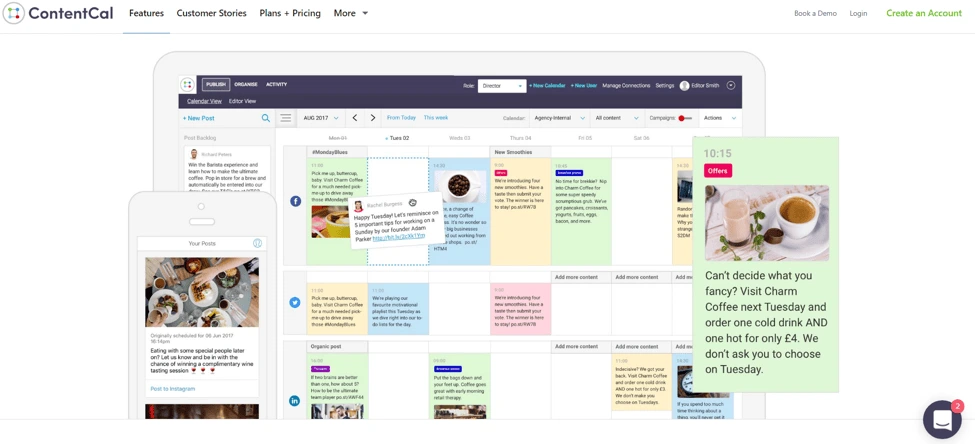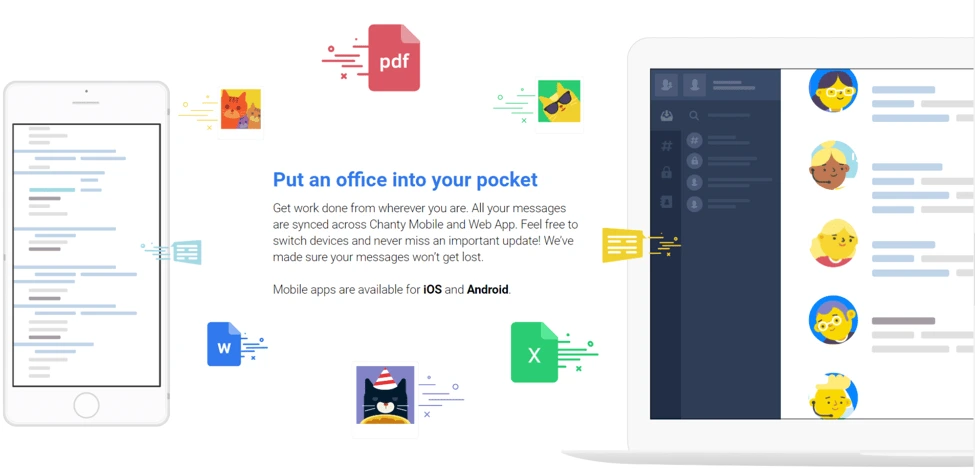Studies show that the average consumer is exposed to up to 10,000 brand messages a day.
To break through the noise, your brand image should be powerful and to the point, like an elevator pitch—an quick and accurate expression of your key values, unique benefits and mission. Delivering it successfully has never been easy, especially if you work with tech brands, which can often be hard to describe succinctly.
Does this sound scary? Probably. Should that be motivating? Surely!
Related: Tech marketing best practices
So what does a tech company brand consist of? What are the steps tech companies take to create a brand that reflects their values and appeals to their target audience?
We talked to 5 experts—startup founders, marketers and designers—about the answers to these questions and about their own brand-building experiences.
Here are the questions we asked:
- How did you come up with the idea of the logo?
- Why did you choose the colors you’re using now?
- What is the key message you wanted this design to convey?
- What are the general impressions and associations you think users get from the brand?
- What advice would you give to a startup working on their own branding?
- How do the current logo, design and tagline reflect the core values of your company?
Here are the insights they shared.
Markus Pirker, co-founder of Userbrain
Userbrain is a subscription-based tool that helps website owners, designers and developers improve their products by providing first-hand feedback from real users.
Before starting work on our logo, we made sure the whole team was aligned with our core values and beliefs. I don’t think you can create something as important as your brand image starting with the details like color choice—you have to work from inside out to create something authentic.
In the process of fine-tuning our core values, mission and vision, we decided to lead with the promise of effortless, ongoing user testing. This inspired the design and served as a baseline to assess the quality of different logo suggestions.

We went through a couple iterations before we decided to go with the current logo. Past suggestions used additional elements, and we tried to narrow everything down to a very simple logo which could be used across different platforms without substantial alterations.
User testing is often regarded as a tool for experts only, which it really isn’t. If you get the basics right, testing your own product with other people will always deliver valuable insights.
There are already several user testing services out there using subtle colors and an enterprise-like look in their branding. As a startup, you always have to fight for attention, so we wanted to stand out by using bright colors.

The Userbrain iOS app icon
We used two different color palettes and paired the main colors of our logo with shiny, vibrant colors like orange and violet.
The vision of Userbrain is to help people build better products by bringing them closer to their users. This is something we wanted to reflect in our logo, with the two circles depicting users and customers blending together.
As in sports, continuity in testing your products is the secret ingredient of user testing. We really wanted to embed the idea of ongoing user testing in our branding.
We ran a couple of user tests on our marketing site to learn more about how people reacted to our branding and service in general.
We had several people mention that it was fun navigating around our site, and they captured the basic idea of our service within a couple of seconds, so I guess we got the basics right here.
However, our branding is always adapting to the new needs—I think that perfect branding is something that evolves over time—you can’t get everything right with the very first version.
Maybe this sounds a little counterproductive, but I’d advise startups not to worry too much too early about their own branding. Startups should focus their early efforts on getting something really minimal yet valuable out in front of people.
This is not meant as an excuse for bad design, but if your product provides value to people and is a clever solution to a real problem they face every day, they will overlook your crappy logo.

The old, quite simple, Userbrain logo
The Userbrain logo has been the word “Userbrain” written in Open sans and uppercase for the first year and a half, and we’ve had customers sign up with no branding at all.
The promise of our service is effortless and ongoing user testing. I think that our team did a great job communicating this idea in a simple yet effective logo.
Tim Sae Koo, CEO at TINT
TINT is a content marketing platform that allows brands to source authentic community content from social media, new and review sites, then integrate it dynamically into any digital channel.

TINT’s logo is a powerful symbol that was designed back in 2012. It represents the connections between brands and their audiences. The intersecting lines resemble customer touchpoints and the circle that surrounds these connections represents our product, implying that these connections are the center of our product.
Warm red is our primary color. It’s meant to signify clearness and power—our brand essence.
The key message is meant to signify that we speak less and say more with design. We use simple and clear design that allows us to speak from the heart. We are direct, consistent, compelling and inviting. We are grateful. We are compassionate.

Start with why you started the company, and translate it into a physical manifestation via logo and branding. The logo reflects our personalities, which stood as the baseline for creating our core company values.

Hayley Snow, Marketing Project Manager at ContentCal
ContentCal is a simple tool to create, plan and publish compelling social media content.

Our logo was born from one of ContentCal’s core components: the approval flow UI. This UI consists of multiple dots on an axis, one for each step of the approval flow.
We started playing around with the concept of dots in a line in all different ways, then started to realize the potential in the idea. With some tweaks to its form, the graphic could morph into a line chart, process circle or share icon.
The flexibility of its form won over our team in an internal design critique. We developed the logo further to give it the form of a system, and after multiple iterations, the new ContentCal logo was born.
There are four brand colors used in our logo. The original UI colors in the ContentCal product were blue and “zing blue” (a very bright cyan), so these became two of the four colors used. We then added green and red, which are the ‘approve’ and ‘deny’ action colors within the product. So the logo looks like a system, and the colors are the ones used in that system.
Our logo doesn’t have a strong key message other than for it to represent our core values and to feel at home in the tech startup world.
General feedback has been that the logo works well in its environment, it feels associated with digital technology, which is definitely what we wanted to achieve. We also have great feedback about our logo being used at a large scale—for example, in exhibition spaces.

My advice to a young startup would be to stay agile with your branding. Branding in tech startups is predominantly used online now, so there are more opportunities to tweak and adapt over time. I also would suggest not worrying too much about brand guidelines at an early stage. Your company should constantly be adapting and growing, and so should your branding.
We’ve made many incremental improvements to the branding both on our website and in printed documents. It’s always adapting, and I think this is the best approach.
Our core values are Flexible, Dynamic, Together and Consistent. Our whole brand is built around these values. As we grow, staying true to this will become more and more important.
Nick Kamyshan, CEO at Chanty
Chanty is a fast and simple AI-powered business messenger designed to increase team productivity.

The idea was to make a dead simple symbol which clearly shows the letter “C” for Chanty and a dot in the middle to emphasize a human being in the center of information flow.
We decided to go for a high-quality logo and hired top-ten Dribble logo designers. After several months of their work and multiple iterations, our tests showed that none of the logo designs satisfied our target audience. Our founder and product owner was extremely frustrated with the low-quality results and came up with our current logo while on a plane.
We’ve tested a lot of color schemes, and it turned out that the color combination we chose is the most attractive to our target audience. It also has the highest conversion rate. I should highlight, however, that this color scheme is mostly used for marketing resources at Chanty, not for the software product.
Laconic is the exact word to describe the look and feel we’ve worked so hard to achieve. We believe that things should be simple. On top of that, laconic crystal clear designs are easy to remember.

Experiment until you die or succeed. Find out which colors really work for your target audience by constantly testing different color schemes via various marketing channels (e.g. launching ad campaigns in Facebook).
Listen a lot. But don’t listen even more. Make discovery a part of your workflow. The more informed you are, the more confident you become.
Be unique, develop your own style, and go in a different direction than your competitors when it comes to branding.
Ksenia Levoshko, UI/UX Designer at Daxx
Daxx is a nearshore staffing company that helps companies hire talented developers.
Tech company branding is more than just the logo or color scheme on a website. The product or service a company sells is the foundational element upon which all branding is built. As your company’s offerings evolve, so should your branding.
The product I worked on consisted of several parts: a wearable device (bracelet or ring), an app, and a web portal. The wearable collected data on vital signs then transferred it to the app, which sent notifications motivating people to take action and pay attention to their health.
The primary objective of the project was quite ambitious: We needed to inspire users to change their behavior. As it turned out, the strongest motivator was the user’s desire for tangible, positive change and the use of personalized data.
That’s why we made a U-turn from a fear-based approach to a new, engaging one. We made it into a game, where at the beginning you see your current health state and set custom goals.
We used points to track users’ success and implemented badges and stickers as gamification elements. Each badge or sticker marked a small achievement that greatly motivated users and helped maintain their enthusiasm.
If you want to ask your audience about something, you have to give them something first. Early on, we asked our users for personal medical data and gave nothing in return. Now, we clearly explain why it’s necessary and how it’s going to change their lives for the better.
Understanding a user’s motivation is crucial. Once you realize what your users need, you can help change their behavior.
Key takeaways
Tech branding is not limited to logo design and a color scheme. Branding also includes the way a company communicates its values and mission, internal company culture, and customer relationships.
In an age of information overload, companies do their best to communicate brand messages as clearly as possible. This includes visual representation: as we saw, most experts prioritize simplicity—minimizing clutter and leaving only the key, nuclear elements that convey their message. Then, they make sure it’s 100% authentic and reflects their ideas and goals.
The experts also agree that designing brand elements is just the beginning of a long path—finalizing and polishing them requires a lot of experimenting and user testing. The branding process is never really complete. As a business evolves over time, the brand image should stay aligned by adapting to changing market requirements and business needs.
Want to know more about how to build your brand? Download our free ebook on how to build a brand in 2020.
Channel partners are a critical source of revenue for tech companies — but if businesses took a hard look at the experience potential customers have when working with a channel sales partner compared to an internal sales rep, those two experiences would be anything but consistent.
In fact, more than half of SE leaders aren’t confident in the delivery of brand consistency across channels during the sales process. This inconsistency comes from gaps between resources across content, technology, and training between businesses and their channel sales partners. Because of this, companies and organizations are beginning to invest more in their partner enablement plans, which has proven to provide 40% annual revenue growth for businesses.
What is partner enablement?
What exactly does this mean for your business and just what is partner enablement? Partner enablement (also referred to as channel enablement) is the practice of ensuring your partners can independently initiate and complete the sales process while also effectively implementing and supporting the customer solution. With so many different channel partners, it’s important to provide resources, templates, training and technology so there’s consistency for your brand.
Challenges of partner sales
As mentioned above, one challenge businesses experience with their partners and sales is that most enterprises provide more resources to direct sellers than channel partner companies. This can be detrimental to your partnerships, especially if your partners feel like you’re wasting their time or resources.
Another big challenge of partner sales is that indirect sellers find it 1.3x to 1.6x harder than direct sellers to get prospects to make a next meeting. Most partners tend to find they have a harder time advancing the sales cycle than a direct seller. This challenge can stem from those gaps in resources mentioned before. These gaps can also stem from the fact that most sales employees are more thoroughly trained than partner reps — companies tend to provide sales employees with the necessary software, templates and devices needed to grow and succeed.
Strategies of partner enablement program
To create a successful channel partner program, you need to have some solid strategies in place. Check out the best strategies below:
Get feedback from your current channel partners
Because you most likely work with partners of all different shapes and sizes, it will be difficult to appeal to them all. Talking to your partners will help you create better services and products, while also finding out how you can help them succeed. Do they need training videos? Would they benefit from incentives or award programs to up sales? Don’t guess.
Provide training
Training will help increase the skill of your partners, helping them become more productive and expanding. You can provide training in several different ways including sessions during office hours where partners can ask technical questions, or a more formal training session like webinars, certifications, or traditional seminars. If you do provide online training, note that research shows you’ll be most successful with videos of 6 minutes or less.
Another way to provide training is to try gamification. If you’ve ever had to do online or technical certification training, you know that it can be boring. Turning training into a game with a ladder of certifications can make training more appealing.
Give recognition
Our need for recognition is universal. A great example of the success of this concept is Microsoft’s Partner of the Year Awards. You can start with a simple MVP award and promote in webinars, training videos or even on your website. Offering recognition like this is an easy way to engage partners and help them connect with your brand.
Sales enablement content
Providing sales enablement content has been proven to boost conversion rates. Companies that deploy sales enablement platforms to their partners are up to 2.3x more effective at achieving their sales goals. By offering sales enablement content you are guaranteeing that all of your channels provide a cohesive brand experience. And as we mentioned earlier, sales enablement content can lead to 40% higher revenue growth. With this content, be sure to provide branded templates that channel partners can quickly find and customize.
Brand templates can help your teams maintain brand consistency along with easy asset storage and access. Our channel management software can help you build a library of content that not only your employees can access but also your partners. With lockable templates you can guarantee that your content and brand will appear consistent throughout all channels while enabling channel partners to customize content for their prospects. A lack of cohesiveness is detrimental to brands today, and Lucidpress makes it easier to keep teams, partners and vendors all on the same page.
As you start to create a channel partner enablement plan, don’t forget to focus on consistency, which will ultimately help your brand expand. For more insight on brand consistency, check out our guide on how to achieve consistent storytelling across sales.
Measuring marketing effectiveness and performance are the keys to your brand’s success. As tempting as it might be to chalk up the effectiveness of your marketing campaigns to pure luck — bookended by witty headlines, captivating CTAs, strong visuals and magnetic content — you don’t want to do that.
Why?
Well, to start, measuring marketing performance tells you a good deal about the health of your brand — not measuring does the opposite.
Second, it puts unnecessary pressure on you and your team to magically market instead of nurturing a consistent, memorable brand experience.
And third, it also makes it incredibly difficult to internally self-market and get sales reps, channel partners and others to use the content you create.
Marketing is only as effective as the measurements you take and make. And the longer you hold off on measuring marketing effectiveness, the longer it will take you to get beyond the “Huh, Well That’s a Good Idea” phase and step into the “Well-Oiled Marketing Machine” segment of your brand potential.
So, if you’ve been using the “I-Don’t-Know-What-Exactly-I-Should-Measure-So-I’m-Just-Not-Going-To-Do-It” excuse, well, then this blog post is for you. Also, for what it’s worth, it’s totally okay if you didn’t know what exactly was worth measuring, because, one simply can not know everything.
Marketing effectiveness: Metrics you want to track
Measuring marketing performance is quite straightforward. To help you get the ball rolling, we’ve compiled a list of metrics you want to track and keep in mind as you concoct strategies, create content and more.
Marketing contribution to revenue — Can you tie your marketing team’s efforts to company revenue? To measure this, create and track key performance indicators, also known as KPIs. KPIs are a great way to manage your team, priorities and new projects. And more importantly, they provide insight into your team’s contributions.
Marketing contribution to pipeline — Can you tie your marketing team’s efforts to current leads or pipeline activity? Or are your leads trapped in Marketing Strategy Pipeline Purgatory, unable to move down the funnel? Be sure to track and evaluate funnel effectiveness, as well as lead growth and acceleration, as a means of identifying marketing health.
Customer lifetime value (CLV) — Do you know your customer lifetime value (also known as CLV)? As in, do you know how much net profit you can expect to gain from your customers? Your customer lifetime value provides solid insight into whether or not your marketing strategies are effective — and furthermore, it’s directly connected to your current customer experience. You can’t have a positive CLV without good customer experiences.
Unfamiliar with the term? Customer lifetime value is the net profit your company earns from a customer. To calculate CLV, take the average, annual profit contribution per customer and multiply it by the average years customers buy from you. Then, from this number, subtract your customer acquisition costs. And there you have your CLV.
If you’re not sure how to calculate your customer acquisition costs (CAC), don’t stress. Start reading the next section… ready, set — now!
Customer acquisition cost (CAC) — Do you know how much your customers cost you? Meaning, do you know how much it takes to get customers to purchase a product or service? Compiling the calculations is pretty simple. Take the total marketing spend on customer acquisition (also known as MCC) and divide it by total customers acquired (CA). The result is your customer acquisition cost.
ROI of creative services — Realistically speaking, do you know your current ROI of creative services? We’re talking about an ROI specifically on the content you and your team produce for sales reps, channel partners and so forth. Connecting the ROI of client creative services helps improve other ROI metrics and also strengthens marketing contribution to the pipeline (e.g., close rates, pipeline acceleration and so forth).
If you’re not sure, ask yourself and your team:
- How many folks (i.e., sales reps, channel partners, etc.,) use your internal design or creative services team?
- How much of your content is actually used by these people?
If your gut tells you that your ROI is pretty small, you’re not alone. Most organizations face similar challenges. For example:
- Most teams struggle with content adoption — 80% of companies feel like cross-functional team collaboration is ad hoc or non-existent.
- Creative time and energy is going to waste — 65% of content goes completely unused by sales reps.
To avoid the two statistics mentioned above, we suggest measuring marketing effectiveness through traditional brand equity measurements. Additionally, your organization could stand to benefit from periodic internal surveys or a brand templating tool.
Market share — How much of your market do you control? The numerical result of this is what you’d call “market share.” To calculate your market share, take the total amount of your company revenue during a specific time period, and then divide that by the industry revenue from the same time period.
Evaluating your current market share empowers you to see how you stack up against competitors and helps you leverage your unique selling points in emerging or even current markets. From there, your market share insights can be used throughout content creation and can be customized per target audience vertical.
Metrics that influence your market share are as follows:
- Brand awareness — Your brand is how people recognize you. To that end, are you telling a consistent brand story across all platforms? Keep in mind, in order to be recognizable, you need to be consistent across every touchpoint and on every piece of content that’s created. Rogue content or off-brand collateral hurts your image, reputation and conversion rate.
- Market appeal — You don’t have to be the most innovative in order to maintain market appeal. You do, however, need to be prepared to shift gears or update your appeal when needed. As fetch as it is to be unconventional and alternative, it’s worth staying in-step with the rest of your industry to prevent your brand from being perceived as outdated and irrelevant.
- Customer engagement and retention — Whether or not you show up and engage with your customers says a lot about your business. So, yes, your customers want you to engage with them. But, no, they may or may not want you to hit them over the head with a bazillion emails a day.
- Delightful content — This is a chicken and/or the egg scenario: you can’t really have one without the other. For the chicken — does your content delight your customers? Do they interact with it and enjoy it? It’s a yes or no question, really. And the egg — do you have enough resources in place to scale content creation? Furthermore, are you empowering your reps and channel partners to create personalized content?
Measuring marketing effectiveness for the long-term
It’s worth noting that while you can track these metrics all day, you need to maintain a holistic perspective on your marketing strategy. Should your numbers or measurements be low, take the time to evaluate your content and customer experience. Consistency between touchpoints and brand storytelling is a critical component in evaluating your brand health and marketing effectiveness. For many companies, achieving consistency is a struggle. If you find your organization is having difficulty iterating a consistent content story or is falling victim to rogue content, we’d recommend reading our ebook (The extra 1%: Delivering a memorable content experience) to learn more about scaling production relative to your customers’ expectations.
Most companies strive for market penetration as soon as they enter a new market to launch a new product. The hope is to enter the market swiftly and capture a sizable market share.
What is market penetration? In simple terms, it’s planning how to grow your business in an already thriving market where similar products exist. When you enter an already established market, you need to have strong implementation and execution strategies in order to get the upper hand against your competitors. This is where market penetration strategies come into play.
Market penetration strategies carry a low amount of risk and are ideal tactics for business growth, especially for startups that are low on cash or can’t invest in riskier growth strategies. Entering an established market is a safe bet as it already guarantees a need for products in your industry.
Before you can start considering which strategy to move forward with, it’s important to note that market penetration can be looked at as a metric or an activity.
Market penetration as a metric
Market penetration as a metric assesses how much of a product is being sold in relation to the total estimated market for that product. This metric is expressed as a percentage. When market penetration is viewed as a metric, it can also be called the market penetration rate.
See the simple calculation below that you can follow to get the market penetration rate:
Market penetration rate = (number of customers ÷ target market size) x 100
This can be calculated if you know your total addressable market (TAM), which is the total amount of money you can make selling your product or service. Sometimes calculating your market size can be tricky, especially depending on the nature of your product. Plus, your potential customer base could be global and your target audience may be “everyone.” The more particular you can be with your ideal audience demographics, the easier it will be for you to calculate.
To know whether or not your product or business is doing well once you’ve calculated your market penetration rate, consider this — the average rate for market penetration for a consumer product should be around 2% to 6%, whereas a business product can range anywhere from 10% to 40%. If you’re able to hone your product to where you can capture around 10% of the TAM in your industry, you’ll be doing quite well.
Apple offers a good example of successful market penetration. Within the smartphone industry, the iPhone has a market penetration rate of 19.2%, whereas smaller brands like Huawei have 10.2%.
Market penetration as an activity
As an activity, market penetration is the process of going to market with a product (in an existing market where current or similar products already exist) and taking market share from competing companies. This can also be known as market penetration strategy.
Market penetration as an activity first stemmed from the Ansoff Matrix. The Ansoff Matrix was developed in 1957 by Igor Ansoff and is used to help companies plan their strategies for future growth. It’s a 2×2 matrix that represents four different business growth strategies including market penetration, product development strategy, market development strategy and diversification strategy.
Market Penetration Strategies
There are several different ways you can approach market penetration and different strategies to apply in order to achieve success. We’ll highlight five strategies below.
1. Improving marketing effectiveness
This may feel like a “no duh” approach, but updating your content and analyzing its effectiveness can go a long way in market penetration. Consider these three ways to improve your marketing effectiveness: content adoption, content effectiveness or content customization.
Content adoption rate
How much of your content is actually being used? If your marketing team is churning out content that is rarely used by the rest of your business, it could be because that content is ineffective (see below for more about that) or because the content is too difficult to find or use. By adopting brand templating, your marketing team can organize templated content in one location that stakeholders can quickly find and customize to their needs.
Content effectiveness
If you’re looking to improve your marketing effectiveness, you need to ensure that your content is on brand and on message so you don’t lose customers to irrelevant or low quality content. Brand education, brand consistency controls and regular feedback from customers and stakeholders on which content is most effective is critical to stand out in a saturated market.
Content customization
Empowering everyone in your organization to customize content is a powerful way to improve content effectiveness. Provide your staff with tools like templates that they can adapt and personalize based on customer and industry insights.
2. Increasing brand awareness
Similar to improving marketing effectiveness, another good market penetration strategy is to increase brand awareness. You can do so through several different ways including branded packaging, upping your presence on social media, working with influencers or leaning into your brand story and personality.
No matter which approach you take with increasing your brand awareness, you have to be consistent with your brand across all platforms and channels. With a consistent brand voice and aesthetic, potential customers can get to know your brand and recognize it easily.
3. Enabling multiple distribution channels
In today’s digital world, it’s no longer enough to simply sell through your personal website or in a brick and mortar shop. You need to post your content on multiple channels, as well as sell your product or service through different distribution channels as part of your market penetration strategy. That can include internal sales, channel sales partners, digital channels, franchises or strategic alliances.
If you’re looking at acquisition, know that by buying a company within your industry, you can practically buy the customer base and the market share along with it. Or, you can buy the competition and shut them down. This business plan may not be accessible for small startups, but may be feasible for more established companies.
If you can’t buy out your competitors, then making a strategic alliance as channel partners with similar companies will help you to capture their audience while also widening your market. Remember to put brand guidelines in place to keep your messaging consistent — it will ultimately make your channel partners’ lives easier too.
Creating a business franchise can also be a well-planned market strategy helping you to stand out among competitors. Franchising can be a cost-effective way to quickly get you into a market, because you won’t be footing the cost for every location. In franchising, franchisees use the brand and open their own location, while the franchisor gets royalties from the profits.
To help with brand consistency across franchises, create a brand manual that will detail things like your brand’s voice and tone, outline a general code of conduct, and include best practices templates. These templates will ensure that franchisees won’t stray from correct branding. Using templates like those provided by Lucidpress will help you create and customize templates so your franchises won’t have to create content from scratch. You can also use a content marketing platform to create, manage, distribute and organize all of your content in one place.
4. Changing pricing
Another effective market penetration strategy is through lowering or raising your prices. In fact, it’s one of the most widely used tactics. Lowering the price of a product with the intent of increasing sales is considered a price adjustment tactic. After analyzing your competitors’ prices, offering lower prices or an openly discounted price (that will be raised later on) can help swing business your way. If you do take this approach, be careful, as overdoing it can lead to the opposite effect that you’re hoping for.
5. Updating or launching products
Small adjustments to your product or service can make a big difference in your market penetration strategy. Reaching out to customers or clients through surveys or researching competitors can help you understand what your audience is looking for along with what they’re saying about your current products. By listening to your customers you can pinpoint essential functions or features that they want. If done correctly, you could end up giving your market something they need but can’t find with any other company.
Whether you choose any one of these tactics to help your business grow, it’s important to note that market penetration won’t affect your overall marketing strategy for your business. Rather, it will bring solid growth potential and increase revenue. However, each of these strategies will require strong implementation and execution in order to compete and grow alongside your competitors. So be ready to stick to your guns and don’t give up too soon.
Want to create a more memorable, consistent brand? Check out our free ebook — The extra 1%: Delivering a memorable content experience.
Top performers in the tech aren’t just taking content marketing more seriously, they’re being more creative with its uses. We’re seeing top performers treat content marketing as a strategic business function, and we’re telling you, it’s pretty cool to witness the creative results.
Take Wistia for example. Wistia ditched the standard resource page and boring blog posts and instead created an almost Netflix-like approach to content marketing with their Learning Center.
But, Wistia isn’t the only company making waves with its stellar content marketing though. By following these seven major trends in content marketing, you too can start to see success.
Related: Tech marketing strategies
1. Continued growth of content marketing
According to a recent survey by the Content Marketing Institute, half of technology marketers (51%) expected their 2020 content marketing budget to be higher than it was in 2019. Meaning content marketing is experiencing a growth surge.
If you aren’t finding success with your current digital marketing tactics, try thinking outside of the box. Check out these examples of content marketing from technology companies that are really making a splash.
Blendtec
You’ve probably heard of Blendtec’s popular YouTube series “Will it Blend?” It’s a social campaign that’s garnered millions of views, and it’s been more than just that. It’s also been a sly bit of product marketing that harnesses the right kind of content for its platform. Blendtec didn’t just start throwing out these videos willy-nilly. They researched what works on YouTube and it’s truly paid off — their channel has 867,000 subscribers and the top video (Will It Blend? – iPad) has over 19 million views.
Squash Games
Co-creator of the cult classic cartoon Rick and Morty, Justin Roiland saw potential in the online fan communities of the show and decided to use it to his advantage when he created the VR brand Squanch Games. Rather than wait for consumers to start conversations about Squanch, Roiland and his team created spaces on the platforms their audience was already using like Discord and Reddit. The discussion channels aren’t overly populated by advertisements or intrusions from Roiland himself, but both websites are linked on Squanch’s homepage, bearing an official stamp of approval.
2. Content for multiple audiences
The average number of audiences technology marketers create content for is 3.8 — thus, expanding your reach beyond one or two audiences can generate new customers quicker than you’d imagine.
It’s more common for technology companies to reach out to multiple audiences on multiple platforms because what works for one target demographic, may not work for the other. The biggest challenge we’re seeing for B2B technology companies is creating content that appeals to multi-level roles within the target audience(s). In fact, 59% of tech marketers say this was their top marketing challenge. To move past this hurdle, we suggest identifying personas at all relevant levels of the organization and create content for each role regularly.
3. LinkedIn as a distribution platform
Don’t underestimate the power of LinkedIn as a distribution platform. We found that 97% of technology marketers use LinkedIn organically while 84% of tech marketers use LinkedIn as a paid platform.
There are demographics available on LinkedIn that you may be completely missing out on. As you move to make your mark on LinkedIn, it’s important to note some new features to be aware of that will ultimately help you reach your target audience:
- LinkedIn Live and LinkedIn Events
- Stories Ads
- Audience Insights
- Document Ads
- Products on Pages (where users can leave reviews similar to G2 Crowd)
- AB Testing/Split Testing
- Campaign Manager Lite
- LinkedIn Business Manager
4. Prioritization of customer loyalty
Current customers are just as important as new ones.In fact, technology companies that see the best results are ones that prioritize customer loyalty — 85% of top performers use content marketing to build loyalty with existing customers. On the other hand, only 58% of all respondents say the same.
By focusing your marketing efforts on current customers, you build an infrastructure that fosters retention and even upsell or cross-sell additional features, products and services.
Here are a couple of other ways you can re-market to pull current customers back in:
- Customer communities: Customer communities can be a safe space for people to “talk shop” with peers, share new information about the industry or even collaborate with other professionals. They can also be a great place to announce eBooks or a new whitepaper.
- Nurturing programs: It’s quite common for B2B technology companies to remove existing customers from marketing automation programs. But rather than lump current customers in with new customers, implement a separate nurturing program for them, with touches occurring less frequently. Instead, try highlighting customer success workshops, live events or webinars.
5. Power of case studies
People trust other people, which is why case studies are one of the most powerful ways to convince consumers that your product or service is the right solution. Among tech marketers, case studies are considered one of the highest-performing types of content.
Case studies can help communicate the value of something technical. By introducing real-world examples, you bridge the divide between the complexity of your product or service, the pain point of the customer and the technical understanding of those involved in the purchase. Surprisingly, case studies are more popular with tech content marketers than with B2B marketers — 82% of tech marketers use them versus 69% of B2B marketers overall.
That said, case studies can be a hard area to get right. Here are a couple of tips for creating useful and successful case studies:
- Introduce the solution and benefit of your product or service right away
- Craft the narrative from a peer-to-peer perspective, and then move beyond
- Humanize the content with pain points or direct quotes
6. Digestible content and interactive experiences
We’ve seen a rise in documentaries and other forms of content as companies look for ways to leverage brand affinity marketing. And while this approach has been used by retail companies for years, tech company branding stands to benefit from it too.
Producing content that connects with your audience on a deeper level can provide something your everyday assets (like sales enablement collateral or email nurture campaigns) aren’t able to.. Your product may feel like a tool more than a service most days, but that can be changed by simply humanizing it (hey, case studies!) through an interactive experience or a fun video series. Don’t believe me? Check out these two companies:
Mail Chimp
One of the first brands to dip their toe into easy-to-digest content, Mail Chimp created a 5-part series called Second Act. The documentaries feature stories of people who were leaving careers to create new ventures. The mini-series highlighted the service that most new companies utilize when starting a business but explained the benefit of it through a heart-warming story of people following their passions.
Yeti
Yeti was among the first brands to create their very own online content highlighting people’s stories rather than focusing on the product. At first, they simply focused on salt of the earth people who used Yeti, but with time, their efforts have moved more towards telling stories that resonate with their audience and leaving the sales-focus behind.
Both of these companies were able to create content that could be turned into a viral series, pulling customers back in, over and over again. A docuseries doesn’t have to be the answer, either. Creating interactive product tours, interactive ebooks, quizzes or personalized content recommendations are all other great starting points that will resonate with your audience.
7. Use of intent data
Intent data is behavioral data collected about a person’s online activities — which is a combination of topic and context data.
Topic and context data provide insight on who the person is behind an action and what topics they’re expressing interest in. For example, by reading this article, you’re expressing a level of interest in trends for technology marketers. This is considered topic data. On the other hand, we might assume that you’re a marketing professional and are therefore searching for a new approach to digital marketing. That’s context data.
Intent data can be incorporated into your sales and marketing platforms to identify and find in-market buyers. Intent data can also be poured into marketing technology like a MAP or CRM. Additionally, 80% of B2B brands are leveraging intent data to help with account prioritization and scoring for ABM initiatives. Successful technology marketers have found that intent data can not only help their sales teams focus their outreach, but it can also focus their advertising dollars to determine which topics to address within their content marketing platforms like social media.
Go from blah to cha-ching
Whether you choose to implement one or all of the trends above, your digital marketing strategies are sure to go from blah to cha-ching. Just remember that quality over quantity should be a priority no matter which path you take. If you’re looking for a better way to give your customers a memorable and unique content experience, check out our eBook on how to get that extra 1% of a memorable content experience.
Many of the current tactics used by tech marketers are falling short of leading to sales. But here’s the thing, there’s often not enough focus on strategy. If you’re finding that your team is great at digital marketing but doesn’t know much about traditional marketing, then you’ve got a problem.
Marketing in today’s world shouldn’t be traditional versus digital. Yes, your marketers need to know about SEO, email marketing, content marketing, etc., but they also need to have a foundation in marketing mix, messaging and the other good stuff that traditional marketing is founded on.
Tech marketing really isn’t that different from marketing for any other company in a different industry. It just takes a little translation to apply it to your business. So, we’ve found seven great strategies to help your team change the way you approach tech marketing, starting with the most fundamental elements of any marketing strategy.
1. Build a strong brand
Branding is one of the most important aspects when it comes to tech marketing. In fact, 60% of brands believe maintaining a strong brand is important when generating leads. It’s crucial for every business out there — your brand is what people will remember most about you. But remember, tech company branding isn’t just about logos and pretty designs; it’s about delivering your company’s mission in a concise way. It’s showing off your personality and telling people you live up to what you promise. With a strong brand, you’ll see a surge in new leads, customers and conversions.
Here’s where to start with renovating your brand:
- Set brand guidelines
- Offer your team a branding masterclass
- Provide branding resources
- Think beyond your website
When correctly implemented, your brand will establish credibility and trust with potential and current customers. Ultimately, a strong brand has a trickle-down effect, boosting your bottom line, employee morale and brand status.
2. Identify your target market
A crucial element to any tech marketing strategy is your audience. You cannot, I repeat, cannot have any marketing strategy, tactic, mission, product … anything without knowing and understanding your target market. Your target market answers fundamental questions that, in turn, influence almost everything you do in your company. Knowing and understanding specifics like what messages resonate with them or what channels will best connect you to them will pave the way for your tech marketing strategy.
Dive deep into the demographics: who your market is (age, ethnicity, gender), where they live, what industries they work in, what they care about, etc. If you don’t know these specifics, nothing else we say from here on out can help. You have to know who you’re creating a product or service for in order for it to work effectively.
As you begin to answer who your target market is, you can then move on to what channels they interact with most and then to what tactics you can use to deliver your message. Getting to know your target market and understanding how your product solves their problems will get you on the right path.
3. Create more effective content
The number of ads a single person may encounter in one day has grown exponentially in the last 20 years. Breaking through that noise to strike a chord with a potential customer can be difficult. And not all of those ads are effective — a lot of them are simply background music that people scroll or swipe past. Sadly enough, 60% of consumers believe that branded content is totally useless. Oof.
Don’t be part of that 60%. Make a point to create more effective content. If you’re not sure whether or not your content is effective, try this simple test we’ve put together.
If you find that your content isn’t as effective as you hoped or assumed, or if you’re just wanting to learn more about how brand templating can help you grow your business, check out our free eBook: Brand templating: How creating more effective content gets results.
4. Host or attend live events
Because audiences are inundated with digital marketing and ads, it’s more important than ever to include face-to-face interactions. Many tech buyers want to get to know you personally in a way that only IRL interaction can provide, and hosting a live event can help. Additionally, integrating live events into your tech marketing efforts can do the following:
- Heighten brand awareness. Sometimes, the biggest challenge when you’re starting out is simply getting noticed. Live events help you showcase the “wow” factor of your product.
- Provide leads. If you’re a more seasoned business, generating leads face to face can be critical for you. Before attending the event, make sure to reach out to key prospects to drive attendance.
- Strengthen customer engagement. Live events can provide an informal, low-pressure environment where you meet and greet current customers. This strengthens your relationships with them, leading to customer loyalty and retention.
- Educate. Educational content and workshops are some of the most effective live event marketing solutions. Workshops can draw in current and potential customers.
Promote the event heavily on social media and stay active and engaged on your social platforms before and after the event.
5. Enable automation
To stay on top of contacting potential leads for your tech marketers, you’ll want to invest in tech marketing automation tools. Automated systems can collect leads, build a marketing pipeline, segment contacts, and market to them on a consistent basis. Marketing automation can help you nurture, qualify, and pass leads from your tech marketing team over to sales when they’re ready. This is an essential tool since pre-sales and sales cycles can last anywhere from weeks to months. Finding the right automation tool will depend on the size of your company, along with the target buyer and the nature of your product.
A few tools you can check out to get you started are ActiveCampaign, Marketo, Pardot, Oracle Eloqua or Mautic.
6. Include influencer marketing
A recent turn in digital marketing is the reliance on influencers to help promote services and products. Business leaders and decision makers are starting to turn to experts in their fields as they evaluate new technologies. A partnership with an influencer or two can help up your credibility and your social media reach.
If you’re like me, you can see the benefits of reaching out to an influencer to help market your product or service. I follow experts and sometimes non-experts to help me when it comes to buying just about anything these days. I’d rather not spend the time doing the research. So if someone else already has done it, then you bet I’m going to take their word for it and invest or buy whatever they’re promoting. My Amazon account can prove it.
Decision makers are beginning to rely more and more on others they trust (or just simply admire) to share their experiences with a solution, platform, product or service before they invest in it. This creates an incredible opportunity for you to leverage influences who already have a loyal following to help market to your target market.
7. Harness video content
Video content has become an extremely prevalent marketing tool for tech companies. Some people just don’t have the time to go through a product datasheet, but we all have a minute or two to watch an engaging, entertaining video about a valuable solution. Here are some areas to focus on when producing original content:
- Great stories. Focus on telling a compelling story. Walk your viewers through how you specifically helped a customer get from point A to point B. Make sure to keep things as simple as possible. You can get into specifics during a sales call later.
- Fun concepts. We know you’re in the tech industry, but that doesn’t mean your videos have to be technical too. Creating humorous videos will help you stand out from the crowd.
- Useful content. As you strive to be funny, don’t forget that your video should also be useful or educational. Your video could be anything from a tutorial or product demo to industry best practices.
- Testimonials. Client testimonials are a powerful tool in marketing. They give potential customers a moment to see a business similar to theirs finding a solution. “If it worked for them, maybe it’ll work for us,” is the mentality.
Whether you choose to implement one or all of these strategies, we know you’ll start to see a shift in your marketing approach overall, along with lead generation. Although simple, these strategies could equal that secret sauce you’ve been needing to change your tech marketing from meh to wow!
And don’t forget to grab our free, mini-ebook Brand Templating: How creating more effective content gets results.